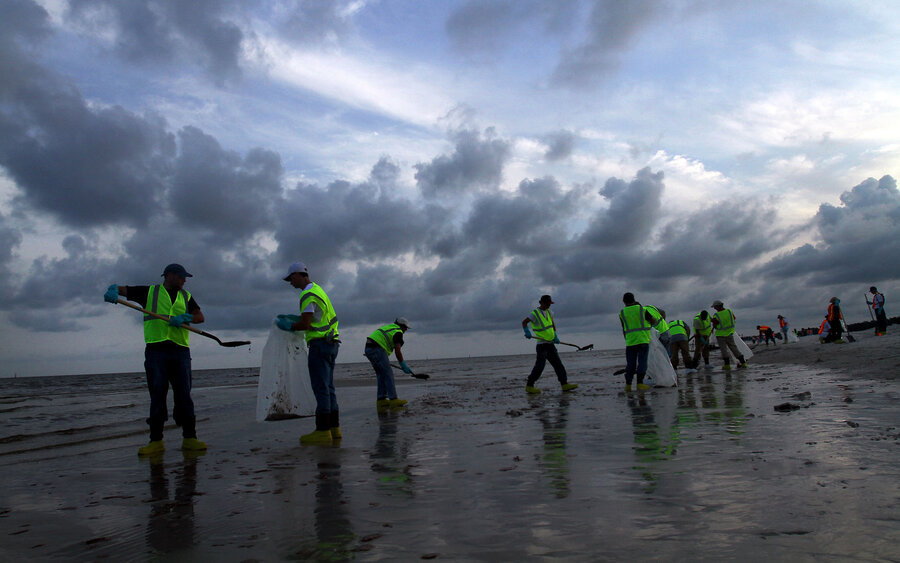How fast will the Gulf bounce back from the BP oil spill?
Loading...
Imagine a hopper filled with 650 quadrillion gallons of warm, salty water and agitated by tough tides, and you have what is, in effect, the giant industrial washing machine called the Gulf of Mexico.
More than 4 million gallons of sweet Louisiana crude oil has likely spilled into the Gulf during the BP oil spill. President Obama has called it the worst ecological disaster in US history, rivaling the Exxon Valdez disaster in 1989, which killed 35,000 birds and nearly destroyed commerce in Alaska's Prince William Sound.
The BP oil spill's toll on sea life, beach towns, and fishing harbors from Texas to Florida is so vast that a $20 billion escrow fund won't likely cover all the damages, said federal fund administrator Kenneth Feinberg.
IN PICTURES: The Gulf oil spill's impact on nature
But as BP attempts today to shut down the Macondo well with a new cap, a look to the future of the Gulf oil spill isn't all doomsday.
Based on past oil spills in the Gulf, including the 1979 Ixtoc rig disaster that spilled 3 million gallons of crude in shallower waters off Ciudad del Carmen, Mexico, scientists say the Gulf's warm, agitating, bacteria-filled waters have a remarkable ability to chomp through even the toughest crude. It's also a place where hurricanes can drive oil inland, but storms can also drag oil off beaches to be refined at sea by natural processes.
Uncertainties abound
Still, the unprecedented use of kerosene dispersants and the deep-water nature of the BP oil spill is littered with unknowns. In localized places such as marshes and beaches, they could stretch the ability of the Gulf's natural restorative powers to correct what one Gulf biologist calls man's "insult" to the ecosystem. Researchers, for example, have spotted fluorescent clouds in the deep Gulf, likely a byproduct of benzene in the water – a new phenomenon.
"It's very possible that five years from now this will just be a nightmare memory that we have, but we also don't know yet if we've exceeded the resilience of the system with this spill," says Richard Snyder, director of the Center for Environmental Diagnostics and Bioremediation at the University of West Florida in Pensacola.
Whatever the case, it seems certain that the damage will not be inconsequential. Oil in marshes could take years to clean up, and fishing communities and beach towns will have to overcome stigmas to rebuild their marketability, even after the oil is gone.
A worst-case scenario of a hurricane blowing large parts of the spill onshore, even into beach towns, could not only disrupt whole communities, but would limit the ability of anaerobic bacteria to degrade the oil left onshore, especially on dry, sandy beaches.
Lessons from history
Yet researchers say that catastrophe has been largely averted in past Gulf oil spills. Some communities of crabs and oysters had vast die-offs after the Ixtoc spill, with some 80 percent of some localized sea life communities perishing. Texas A&M marine biologist Wes Tunnell, who studied that spill, at the time thought sea life around affected beaches would, in essence, vanish.
But a 1981 report by the Coordinated Program of Ecological Studies found that natural conditions – including ultraviolet light, warm, evaporative temperatures, and microorganisms – broke down the vast majority of the Ixtoc slick before it made landfall. Two years after the spill, shrimpers found the shrimp stocks had completely rebounded.
"There was recovery within a couple of years over several different habitats for several different organisms," Mr. Tunnell told the New Orleans Times-Picayune newspaper. The Ixtoc spill "is not having a wide effect today."
'It shifts the whole food web'
But the BP oil spill is different from the Ixtoc in several important ways, says Mr. Snyder at the University of West Florida.
Scientists have found plumes of oil in deeper parts of the Gulf, with one plume encroaching within 20 miles of Pensacola.
Moreover, oil-eating bacteria munching on the spill, out-compete phytoplankton – the basis of the Gulf food chain – for other nutrients like phosphorus and nitrogen, in essence starving the phytoplankton.
"It shifts the whole food web," says Snyder.
"What a lot of us are concerned about is about the impact of a spill of this magnitude where things may recover or seem to recover, but we get this subtle degradation of the environment that's hard to quanity from repeated impacts," says Snyder. "There is a point of no return where we exceed the resilience of the environment. Have we done that [with the Gulf oil spill]? We don't know."
IN PICTURES: The Gulf oil spill's impact on nature
Related:





